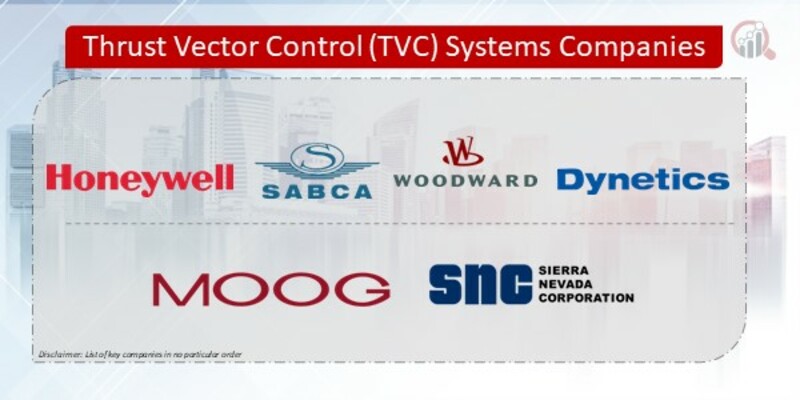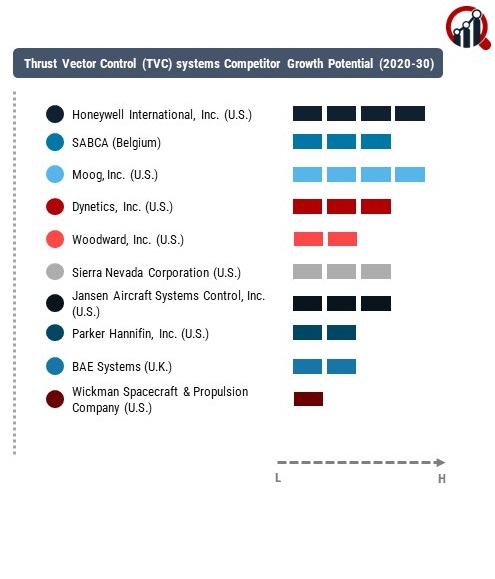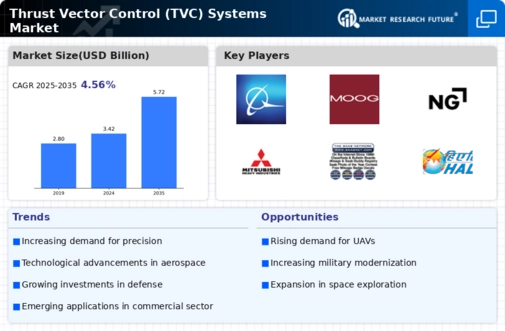Top Industry Leaders in the Thrust Vector Control Systems Market

Strategies Adopted:
Technological Innovation: Key players invest in research and development to develop advanced TVC systems that enhance the maneuverability, performance, and efficiency of missiles, rockets, and launch vehicles. This includes advancements in control algorithms, actuation mechanisms, and materials to improve reliability and precision.
Strategic Partnerships: Collaborations and partnerships with aerospace primes, government agencies, and research institutions are pursued to leverage complementary expertise, share resources, and access new markets. Strategic alliances enable companies to broaden their product portfolios and offer integrated solutions.
Market Expansion: Expansion into emerging markets and regions with growing demand for TVC systems, including Asia-Pacific and the Middle East, through joint ventures, acquisitions, and partnerships. Diversification into adjacent sectors such as commercial space launch, satellite propulsion, and defense applications enhances market presence.
Customer Focus: Understanding customer requirements and providing tailored solutions to address specific mission needs, including integration support, aftermarket services, and lifecycle management. Building long-term relationships with defense contractors, space agencies, and commercial operators fosters customer loyalty and repeat business.
Key Players:
Honeywell International, Inc. (U.S.)
SABCA (Belgium)
Moog, Inc. (U.S.)
Dynetics, Inc. (U.S.)
Woodward, Inc. (U.S.)
Sierra Nevada Corporation (U.S.)
Jansen Aircraft Systems Control, Inc. (U.S.)
Parker Hannifin, Inc. (U.S.)
BAE Systems (U.K.)
Wickman Spacecraft & Propulsion Company (U.S.)
Factors for Market Share Analysis:
Technology Leadership: Companies that develop proprietary TVC technologies and hold patents for innovative solutions have a competitive advantage. Differentiated offerings such as thrust vectoring vanes, electromechanical actuators, and fluidic control systems contribute to market leadership.
Performance and Reliability: TVC systems must meet stringent performance and reliability requirements in harsh operating environments, including extreme temperatures, high G-forces, and vibration. Companies with a proven track record of delivering reliable and mission-critical solutions gain market share.
Cost Competitiveness: Providing cost-effective TVC solutions that offer high performance and value for money is essential for market success. Companies that optimize manufacturing processes, reduce lead times, and offer competitive pricing strategies are well-positioned to capture market share.
Regulatory Compliance: Compliance with regulatory standards and certification requirements, including ITAR (International Traffic in Arms Regulations) and MIL-STD (Military Standard), is crucial for market access and competitiveness in the global TVC systems market.
New and Emerging Companies:
Blue Origin, LLC (US)
Rocket Lab USA, Inc. (US)
Firefly Aerospace, Inc. (US)
Relativity Space, Inc. (US)
ABL Space Systems (US)
Rocket Lab Ltd. (New Zealand)
Vector Launch Inc. (US)
Gilmour Space Technologies Pty Ltd (Australia)
Isar Aerospace Technologies GmbH (Germany)
PLD Space (Spain)
Current Company Investment Trends:
Research and Development: Continued investment in R&D to advance TVC technologies, improve performance, and reduce costs. Focus areas include electromechanical actuators, thrust vectoring control algorithms, and adaptive control systems.
Manufacturing Optimization: Adoption of advanced manufacturing techniques such as 3D printing, CNC machining, and automation to streamline production processes, enhance quality control, and reduce lead times. Investment in modern manufacturing facilities and infrastructure to meet increasing demand.
Market Expansion: Expansion into adjacent markets such as commercial space launch, satellite propulsion, and hypersonic propulsion systems through strategic acquisitions, partnerships, and investments in technology startups.
Overall Competitive Scenario:
Intense Competition: The TVC systems market is highly competitive, with multiple players vying for market share. Competition is driven by technological innovation, performance differentiation, cost competitiveness, and customer relationships.
Market Consolidation: Consolidation through mergers, acquisitions, and strategic alliances is expected to continue as companies seek to expand their product portfolios, gain access to new markets, and achieve economies of scale.
Regulatory Environment: Compliance with stringent regulatory requirements, export controls, and security standards is critical for market entry and success. Companies must navigate complex regulatory landscapes and maintain high levels of compliance to operate globally.
Recent Developments
The flex nozzle segment of the global thrust control systems market is estimated to lead the market during the forecast period ending in 2028. The growth of this segment is attributed to the increased implementation of flex nozzles in a series of satellite launchers and missiles because of the in-built movable seals and high actuation power.
The fighter aircraft segment as a part of the thrust vector control systems market has been projected to witness the highest growth during the forecast period. There has been a huge rise in the acquisition of fighter aircraft with super maneuverability features from various countries like China and India is likely to be witnessing an expectation to drive the market during the forecast period ending in 2028.
The defense segment, as a part of the thrust vector control systems market size, is projected to lead the market during the ongoing forecast period. This is due to an increased need and substantial demand for highly maneuverable fighter aircraft to gain a series of advantages over aerial opponents.










